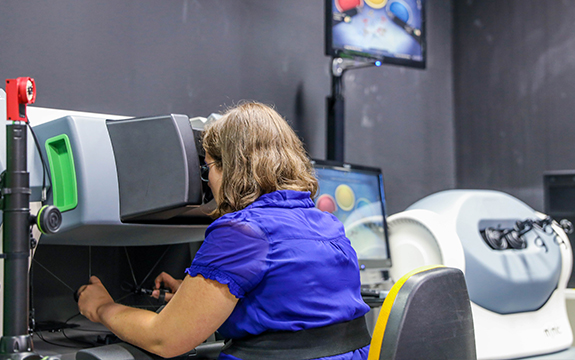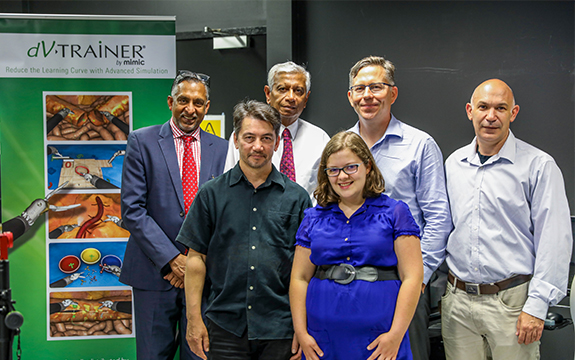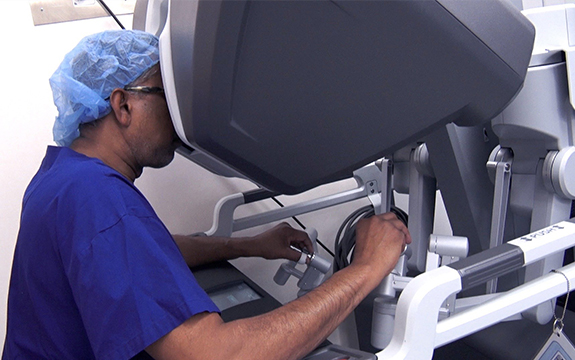Investigating how robot surgical systems could extend surgeons’ careers

In Summary
- Unique study investigates benefits of robot-assisted surgery for surgeons
- Researchers will compare the biomechanics of surgeons during robot-assisted operations with traditional procedures
- Research conducted in collaboration with the Valley Private Hospital and Device Technologies
Swinburne researchers are conducting a first-of-its-kind study examining how robotic surgical systems could extend the career-span of surgeons.
In a unique collaboration with the Valley Private Hospital and Device Technologies, a multidisciplinary team led by Dr Mats Isaksson will compare the biomechanics of a surgeon operating with a Da Vinci Skills Simulator to that of a traditional laparoscopic surgical procedure.
The project’s clinical lead and Valley Private Hospital surgeon, Dr Chris Hensman, says he is eager to collaborate with Swinburne on this innovative new project.
“Thirty per cent of surgeons prematurely end their career due to repetitive strain injuries, poor posture and working at unnatural angles,” Dr Hensman says.
While the surgeon has full control over its movements, the surgical robot has greater dexterity and can be manoeuvred to perform intricate movements more easily, and with less strain on the surgeon, than traditional manual procedures.
“The Da Vinci robot allows the surgeon to sit comfortably and operate for longer and is also an excellent training tool that ensures surgeons are prepared to perform procedures,” Dr Hensman says.
Expertise from a multidisciplinary team

L to R: Dr Chris Hensman, Dr John McCormick, Professor Romesh Nagarajah, Jaime Hislop, Dr Mats Isaksson, Dr Oren Tirosh.
Dr Isaksson says the project will draw on expertise from a range of areas at Swinburne, including mechanical engineering, interactive media to track the surgeon’s movements with motion capture technology, and biomechanics to analyse the movements.
“We want to track everything so we can put the data into a model and calculate things like ergonomic strain to show the differences between traditional and robotic laparoscopic surgery,” Dr Isaksson says.
“This will allow the team to quantify the differences between robotic and traditional surgery, which has not been done before. We will be able to prove to what extent robotics are better for the surgeon.”
Supported by Director of the Iverson Health Research Institute, Professor Gavin Lambert, the research team will include:
- Dr Mats Isaksson, Senior Research Fellow
- Professor Romesh Nagarajah, Professor of Mechanical Engineering
- Dr Chris Hensman, surgeon at Valley Private Hospital
- Dr John McCormick, Lecturer in Interactive Media
- Dr Oren Tirosh, Lecturer in Biomechanics
- Jaime Hislop, PhD candidate
The future of robot-assisted surgery

The robotic surgical system allows surgeons to sit more comfortably, avoiding long-term strain.
Dr Isaksson says while this is just the beginning of Swinburne’s research into robotic-assisted surgery, the future applications for this technology are extensive.
“The use of surgical robotics will continue to increase around the world, so now is a great time to explore and be at the forefront of understanding the benefits of the technology,” Dr Isaksson says.
“My area of interest is in how we can improve these robots to even better serve patients and surgeons alike. It would be great to get to a point where the robot provides sensory feedback when it touches certain areas, or for how much pressure is being applied,” he says.
Dr Hensman says he has long been interested in quantifying the benefits of robot-assisted surgery and is thrilled to be involved in the project.
“It’s a great feather in the cap for Swinburne moving into this under-explored space. Congratulations to all those involved for being at the forefront of this exciting new technology.”

